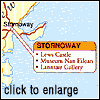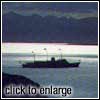|
The Western Isles
The real beauty of these wild outer-lands is in their
natural form. Man's interaction has done little to disturb this and it is, no doubt,
the remoteness from modern civilisation that has helped to preserve some of the most
essential elements of the place.
If you are walking or even driving, the grey skies
and barren landscapes still enter your sight and soul. Some may find this disconcerting
but others relish it and most feel curiously uplifted, having visited such a wild
and forbidding place.
 Getting to the Western Isles may seem an arduous task. You
can take ferries from Ullapool on the north-west mainland or from Uig on Skye, not
easy places to reach in themselves, or from Oban to South Uist and Barra. Regular
airline services also leave from Glasgow flying into Stornoway, Benbecula and Barra. Getting to the Western Isles may seem an arduous task. You
can take ferries from Ullapool on the north-west mainland or from Uig on Skye, not
easy places to reach in themselves, or from Oban to South Uist and Barra. Regular
airline services also leave from Glasgow flying into Stornoway, Benbecula and Barra.
In essence, the Isles are pure place with little evidence,
apart from Stornoway, of modern pressures to spoil it. Urban congestion, if you could
call it that, only takes place in Stornoway on a Saturday night and noise pollution
consists of the howl of the wind. The scenery throughout this island string is simple,
essentially sea, sky and low-lying, bare-boned rocks with ample scattering of fine,
sandy beaches.
Stornaway
Stornaway is the main town on the east coast of Lewis
and the centre of Hebridean life with some 8,000 of the Western Isles population
living in and around the town. Still a fishing centre whose heart is its harbour,
that industry now exists as a mere echo of the activity that took place here a hundred
years ago. A thousand fishing boats and coastal steamers used to fill Stornoway harbour
throughout the nineteenth century, landing their catch and preparing to return to
the bountiful Atlantic.
Following World War I, Lord Leverhulme of the Lever
Brother's empire decided to develop some of the facilities on the islands with the
hope of making them the capital of a huge fishing industry. He actually bought the
island of Lewis, but a recession and collapse in the herring market put an abrupt
end to his plans.
The regular ferry from Ullapool causes a stir around
Stornoway with the arrival of tourists as well as cargoes of mainland wool for Harris
Tweed weavers, timber for an almost tree-less land and various manufactured goods.
The town of Stornoway can be rather grey and unappealing if the weather is similar
but on a warm summer's day it has a pleasant mainland market-town air, a fine place
to sit and watch island life go by.
There are plenty of amenities such as hotels, bars
or grocers but bear in mind that everything including filling stations close on Sunday
to observe the Sabbath. Hotel restaurants are kept open for meals but this is about
all. Some B&B landlady's prefer you to book ahead on a Saturday for a Sunday
stay. They even padlock the swings in children's parks. The same exists throughout
Lewis, Harris and North Uist, the domain of the Free Presbyterian Church, while the
predominantly Catholic islands of South Uist and Barra are more moderate regarding
opening times.
The town is crowned by Lews Castle which is surrounded
by the pleasant, wooded grounds of Ladylever Park with advantageous views over the
harbour. Next to the park is an 18 hole golf course and the town is a good sea-angling
centre. Just off the main square in the town hall there is an art gallery, "An
Lanntair', which displays local and national exhibitions and hosts various musical
events. The Museum "Nan Eilean" is in Francis Street.
It is worth seeking out a bilingual map such as the
Western Isles Leisure Map from one of the outlets in Stornoway before you depart,
as all the road signs are in Gaelic.
The rest of the island
Following the A857 out of town and travelling north
west, the interior of Lewis looks bare, a peat moor where the only sign of human
activity is in the dark, loamy channels cut everywhere to extract peat fuel, the
islands' main source of heat. If it is May or June the men will be cutting peat which
costs no more than the labour of cutting, stacking it and later in the summer, collecting
it.
The A857 continues up the north-west coast to the
Butt of Lewis, a rocky headland some 30 miles (48km) from Stornoway, worth the trip
to see thousands of seabirds that congregate around the lighthouse and cliffs. The
village of Ness and its surrounding area are surprisingly well populated and the
Harbour View Tea Room is worth a re-fuelling stop.
Following the road south again leads on to the A858
and the small community of Arnol where the Arnol Black House Museum shows the lifestyle
of crofters not so long ago. This house was built in the 1870s and inhabited until
the mid 60s - a fairly chilling thought if you are used to all the comforts of a
modern home. There was no chimney and so the interior rafters and much else caught
the soot from the fire. These long dwellings were common throughout the Hebrides,
built without mortar or bricks and usually thatched but without eaves.
At Bragar, the next group of houses on the main road,
stands a massive whalebone archway with the harpoon used to kill the poor beast hanging
from its centre.
From the Butt of Lewis these islands, only twelve
of them populated, run along a 130 mile (209km) vertebral column lying 30 to 50 miles
(48 to 80km) off the Scottish mainland. The northern-most land-masses of Lewis and
Harris are joined by a narrow isthmus although, despite their close proximity, each
has its own unique topography and character. Lewis is largely rolling moorland with
low-lying hills, hundreds of sparkling little lochans and a rugged coastline, while
Harris is more mountainous.
Shawbost is the next community and has a small museum
which illustrates the old way of life for islanders. This was brought together by
school children of the area some years ago and a few of the items are the worse for
wear. Carloway, further down the A850, is another taste of life before the twentieth
century reached Lewis. Carloway Broch, found on a minor turning a mile or so beyond
the village and a slight hike over a track, is a 2,000-year-old, circular, drystone,
fortified tower and probably one of the best preserved brochs of its kind in Scotland.
The sea ward wall stands around 30ft (9m) high.
There are many brochs along Scotland's coasts but,
apart from Mousa Broch in Shetland, few are in such good order. These were probably
built to protect natives from sea-borne raiders, possibly Roman slave-traders.
Located close to A858 beyond the village of Callanish
along the B8012 is the 5,000-year-old standing stones of Callanish, a circle and
avenue of 71 megaliths almost as famous as Stonehenge in England. Its cruciform shape
was probably formed over many centuries from 3000BC to 1500BC. Nineteen monoliths
lead north from a circle with more fanning east and west. The fact that the avenue
of stones to the north completes a Celtic cross is rather baffling as it was constructed
at least 1,500 years before Christ.
Harris
To drive to North Harris from Callanish is a distance
of around 50 miles (80km) as you have to back-track to Stornoway, then follow the
A859 south. This leads through the area known as the 'Lochs' due to the multitude
of small lochans and deep, penetrating sea lochs.
The bare peaks of North Harris appear, a stark contrast
to moors and bogs of its larger northern neighbour. The highest peak is An Clisham
at 2,621ft (799m), clearly seen from the road. The most elevated areas are found
on the east side of Harris with more fertile land on the west. These rocks were old,
long before the glaciers of the Ice Age scraped them clean of soil, a part of a North
Atlantic that was once part of Greenland until the Atlantic drove in between them.
The mountains of Harris trap the township of Tarbert
in its narrow isthmus reached by descending down into this ferry port. There are
many good walks around this area, details of which are provided by the tourist office
in Tarbert. Here you will also find out where to see the world famous Harris Tweed
being woven.
Harris Tweed
The nineteenth century brought the sporting gentry
to the Hebrides and they adopted the local, hand woven tweed originally made by the
women of the islands to clothe their families. The success of the cloth is borne
out with nearly every croft having its weaving shed.

The colours of the Hebridean landscape are said to
be woven into the tweed. To see the techniques used in their original form a good
stop is Clo Mor in the village of Likisto, some 4 miles (6km) south of Tarbert on
South Harris following the A859 then branching left at the sign-post to the village.
To the east of Tarbert is a new 'fixed link' or bridge
to the island of Scalpay. This is the first in a series of links to connect some
of the Western Isles less accessible areas. There are causeways planned soon for
Eriskay and Bernary.
South Harris
On South Harris, the single-track road winds over
to the west coast of the island and offers glimpses of the superb stretches of sparkling
beaches of which the Western Isles are famous.
Leverburgh is past on the south-west corner where
Lord Leverhulme turned his attention after the failure of his enterprise in Stornoway.
He spent a fortune building new harbours and buildings, but died soon afterwards.
A passenger ferry crosses from here to North Uist
and Berneray. The island of Berneray lies off the north coast of North Uist, a favourite
destination of Prince Charles. It is the only populated island in the Sound of Harris.
Continuing east from Leverburgh you enter Rodel on
the southern tip of Harris. St Clements Church in Rodel is one of the finest in the
west of Scotland and contains the magnificent sculptured tomb of Alisdair Crotach
Macleod, a chief of the clan and the eighth chief of Dunvegan.
North Uist
The Sound of Harris separates Harris from North Uist to the
south, which is reached either by the passenger ferry at Leverburgh or by car ferry
from Tarbert or Uig on the Isle of Skye, both of which land at Lochmaddy.

Lochmaddy is a pleasant little town, the main centre
for North Uist and a good place to establish a base if you wish to tour this area.
There are banking, provisions and accommodation facilities.
There is a useful circular route following the A867
and it is advisable to explore the side roads that lead down to trout filled lochans
mainly on the rolling east side and broad silver beaches found on the west of the
island.
There is also agreeable farming country on the west
but it is the great expanses of white sand beaches that are the islands' best feature.
The remote island of St Kilda lies 41 miles (66km) WNW of Grimish Point which is
on the north-west corner of North Uist and the island's nearest substantial landfall.
Benbecula
North Uist connects by a long causeway and bridge
with Benbecula via Griomasaigh or Grimsay. Benbecula is where Bonnie Prince Charlie
and Flora MacDonald met and then departed 'over the sea to Sky." It is a rather
water-sodden, spongy spot apart from its west coast which holds a fertile strip and
the ubiquitous west coast beaches. There is an airport and army base on the north-west
corner which swells the population and economy significantly, but recent government
cut-backs have threatened this. The main road cuts straight through Benbecula covering
its 4 mile (6km) length, then joins another causeway to the island of South Uist.
Both the Uists as well as many spots on Benbecula
are ideal angling terrain with hundreds of erratically shaped lochans. Sea trout,
brown trout and salmon can be caught. Fishing is particularly popular on the machar
lochs of South Uist for beautiful wild brown trout and in the shallow sea for salmon,
sea trout and mackerel. A variety of shellfish are collected and eaten by the locals
including cockles that can be gathered when the tide is out on either side of the
causeway.
South Uist
Your entry into the long island of South Uist is marked,
about 5 miles (8km) after the causeway, by a 125ft (38m) Statue of Our Lady of the
Isles, perhaps to remind visitors that they have left the land of the 'Wee Free'
Kirk and are now on Catholic soil. The A865 is the back-bone communication route
through South Uist travelling around 20 miles (32km) from the north to south. Off
this there are numerous side-roads leading west to the most wonderful stretches of
beach.
The village of Howmore is worth stopping at, very
pretty in itself, and offering a good trek over to a breathtaking part of the western
coast. The next turning after Howmore leads to a minor coastal route but it is easy
to lose your way. Close inspection of a good map is recommended. A stone cairn marks
the birthplace of Flora MacDonald in 1722 just off the main road at Milton.
The main base for a stay on this island might be Lochboisdale
but, in spite of its facilities such as a bank, shop and harbour, it is not an inviting
place. Better still to seek out B&B in one of the cottages around the south end
or the hotel at Daliburgh, although pre-booking is always advised in the summer months.
Eriskay
Off the south end of South Uist you can see the island
of Eriskay, where the SS Politician went down in 1941 with her cargo of 24,000 cases
of whisky bound for Jamaica from Liverpool. This inspired Compton Mackenzie to write
his novel Whisky Galore in which the islanders made brave attempts to 'rescue' the
cargo, much as happened in reality.
A car ferry runs from Ludag on South Uist to the island
of Eriskay, although it is not really necessary to have a vehicle on this tiny island
as most of it can be better appreciated on foot. This was the first landing place
of Bonnie Prince Charlie on Scottish soil, on 23 July 1745.
Barra and Vatersey form the southern tip of the Hebridean
Island chain. Again, a single track road provides the main link for the tiny island
community of Barra although the airport is situated on a spur to the north of the
island. Here the daily Loganair service from Glasgow, Benbecula and Stornoway lands
on a long strip of white shell sand, timed to catch low tide. Near here at Eoligarry
is the arrival and departure point for the passenger ferry to South Uist.
Barra
The approach by ferry from Oban, Mallaig or Lochboisdale
to Barra is quite delightful, with the striking Kisimul Castle standing out on an
islet in the Sound of Vatersay. Its main tower dates from around 1120 and is surrounded
by water. The castle was completely ruined by fire in the late eighteenth century
and remained so until the forty-fifth chief of the MacNeil clan, an architect, returned
in the 1960s from his adopted home in America and restored it to its present admirable
condition.
Castlebay, Barra's main town, stands out on the rocky
eastern coast, a gem of a little port with well-ordered cottages and shops. Above
is the rise of 1,260ft (384m) of Heavel, the highest in Barra and upon its slopes
stands the statue of the Blessed Virgin and Child.
Barra is an ideal escape for walkers who can circumnavigate
the island in a day. Thousands of species of wild flower can be found and Barra is
carpeted with primroses in springtime. Halaman Bay on the west coast is one of Barra's
most bountiful. The popular Gaelic festival 'Feis Barraigh' is held on the island
every year in the first fortnight in July.
The nearby island of Vatersay can now be reached by
a causeway from Barra. Again, it offers lovely beaches and invigorating coastal walks.
Mingulay
A string of tiny flatter islets form the tails of
the Outer Hebrides. The island of Mingulay at the southern end of the Western Isles
is like a scene from Robinson Crusoe. It is often referred to as Bird Island as it
was evacuated at the turn of the twentieth century and given over to the populations
of seabirds that inhabit the cliffs. When there was a community here they made a
harvest of the birds, climbing up from boats onto the treacherously sheer walls to
catch them on their nests.
One hundred years ago there were 150 people living
here. The only substantial house left standing is the priest's house, but this was
never really occupied as around the same time that it was completed in 1908 the people
decided to leave the island.
Tiree, with beaches facing every direction, is a haven
for wind surfers.
|



